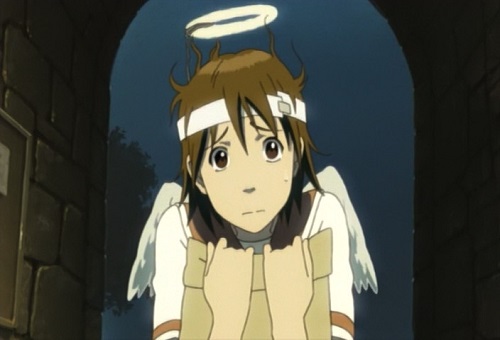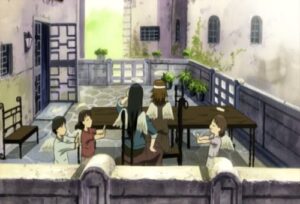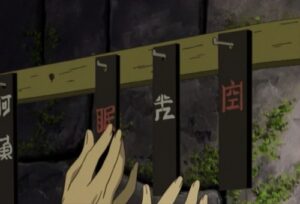Welcome everyone to week 2 of Haibane Renmei! This episode isn’t to surprising. It establishes the setting of the story and a number of surrounding locations, but what a setting it is. We have a lot to talk about this week so lets skip the animation and jump into it!
Right away I have to say that I was impressed not only by how much information Haibane Renmei packed into the episode but how natural it felt. There were no long winded exposition dumps or classroom scenes with a map. Instead it was a series of events that fit together, each opening up a new aspect of the world. Take the start of the episode for instance: After a while of running around in rags the others eventually offer to take Rakka into town to get clothes. From there getting clothes leads into a discussion of money, work and their place in the town. With that leading into the nature of the town itself and how it connects, or in this case doesn’t, to the rest of the world. I want to say this is nothing special. But with how anime normally treats exposition it honestly kind of is.

This brings me to what I feel is the main subject of Haiben Renmei as expressed through its world: Religion. Everything aspect of this episode was steeped in it. Of course there are the obvious symbols such as the wings and halos or Rakka’s almost monk-like robes. However those are just the most in your face examples, the episode has many more. For instance: The Haibane aren’t allowed to have money or really own things, though they sorta circumvent this with the books. Instead they have to survive off of the generosity of the town and this mysterious organization we will talk about. This is very similar to the old vows of chastity and poverty that priests used to make, though whether or not they kept to them is a whole different discussion.
What’s interesting to me about this though is how they circumvent it. As I said above, the Haibane use these little books to record hours worked and effective “money”. For all intents and purposes this is no different from having physical money, it just runs on a credit system. Yet for some reason this town, and the organization, see it as different and allow it. Letting them work and then debiting them some money. Thus giving them at least some autonomy to buy cheap things, food, etc. What I’m curious about though is if this has any kind of real life analogue or if its just a criticism of religion and how it circumvents its own rules. I expect though that as we continue to watch Haibane Renmei any criticisms of religion will only become more obvious.

Moving on, lets talk about Haibane Renmei next! Not the show, we are already doing that, I mean the religious organization. To put it simply, I think these guys are pretty weird. Once again Haibane Renmei is mimicking religious vows with the Vow of Silence, their inability to speak in the town. Yet once again they are shown to be circumventing this vow through the use of hand signs and an interpreter. This begs the question: Why? If they are circumventing it, why the vow at all? What could talking to the town do other than perhaps break their air of mystique? Because of how often Haibane Renmei is doing this, replicating religious tenets, that I think its more than simple set-dressing. Whether or not this is a critique or not though is something we will have to wait and see.
This vow of silence isn’t where the Haibane Renmei organization stops though. We also learn that they provide for the Haibane and are the only ones allowed outside of the wall. While these might seem like small details they imply a lot about Haibane Renmei’s world. That there is a civilization outside of the walls, that the Haibane are a known factor in one way or another and are being sent here, that there are people in charge of all of this, etc. You could maybe make a case for all of this being an allegory for Heaven or Hell, that fits into the overall religious theming of the show. I think its a bit to early to make these kinds of calls but it’s certainly something that I’ll be thinking about moving forward.

Finally I want to talk about some random side queries I had. Stuff like: What are the implications of the child Haibane. Do Haibane grow up or were they all birthed at the age they are now? Are the wings vestigial or can they actually use them to fly? How/why do the halos stay on their head? What’s with the concerning check-in sticks at their home so that people can know where they are? There are a lot of these interesting little details that prompt engaging questions. The kind of things that give it an air of… intent. With a lot of modern shows, lets take Kimetsu no Yaiba for example, it often feels like details are either ignored or thrown in because they are “cool” rather than because they fit the story. But so far Haibane Renmei hasn’t had that problem.
So yeah all in all I would say that was a successful episode of Haibane Renmei. It was primarily exposition about the world but where many anime dump it on you all at once Haibane Renmei was content to slowly doll it out. Letting you become invested and interested in the world before it starts trying to teach you about it. In that I can say it succeeded. I’m curious about the wall, the organization, what the Haibane are, etc. The question now becomes: What is Haibane Renmei going to do with it? What kind of over arching story will it tell? Maybe it will become a weekly Slice of Life that slowly reveals the mystery of the world. Maybe it will will have an actual focused arc. Only time will tell and I look forward to watching it.





I do remember Haibane Renmei having quite a bit of religious themes behind it, but I never once thought about the more subtler things, like how the Haibanes’ life styles could be parallel to how monks and priests used to only live on the generosity of overs. And the only reason I even know the latter is even a trope is because my high school made us read Siddhartha once, and the earlier chapters had the main character and his friend join an intentionally impoverished sect as a means of potentially achieving enlightenment. I hated that book, by the way. Psgels really meant it when he said that the more times you watch Haibane Renmei, the better it becomes.
Haha a shame about the book. Glad I thought of a new way to look at it/brought something new to the table for you!
Haibane Renmei is one of my favorite anime and pretty much got me into anime. The show was low budget for its time but the artists did a great job with what they had.The story is so unique that it stays with you even after the anime ends.
For me, this is one of those shows I know I’m gonna love in the end, but still require the right state of mind to watch. It took me 3 or so years to get over ep1 of Technolyze. Similarly, I’ve watched 2 Haibane Renmei episodes years ago and still havent gotten to it. It kind of bored me, just like Texhnolyze.
Anyway, this is definitely a gem. And I love the smoking girl and her VA (Tsugumi from Ever17 btw).
Im gonna be honest, I’m liking Haibane Renmei much more than I did Texhnolyze so far.
There was a huge amount of theorycrafting back in the day, based on Christian symbolism (a rare and exotic religion in Japan at about 1%, except for the weddings), but I don’t remember this aspect being brought up.